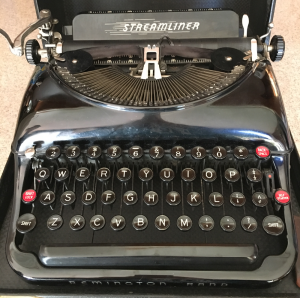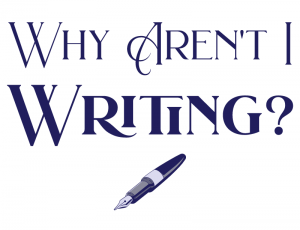It turns out that typing and handwriting aren’t the same. Are you choosing the right one for the job?

One of my favourite insights into the writing process is this short talk from tech journalist Clive Thompson about the cognitive difference between handwriting and typing. If you have ten minutes, take a look.
If you don’t, the tl;dr is that the brain works differently when you’re writing something by hand compared to when you’re typing, and you need to be mindful of what you’re trying to achieve when you choose whether to type or handwrite.
Handwriting is good for taking notes, for example, when you’re listening to a talk. People who take handwritten notes understand and remember more than those who type, possibly because you have to synthesise the information as you go along. People who type (this used to be me!) merely transcribe.
Handwriting “also seems to work very well for big picture thinking” says Thompson. “Whenever I’m writing a big article or a chapter in a book or even designing this presentation, I need to work on paper to sort of organise the flow of ideas and architecture.”
Typing, and particularly fast typing, is the best way to get out ideas that have already formed in your head.
“Fast typing is significant because it’s something that psychologists who study composition call ‘transcription fluency’,” says Thompson. The faster you type, the easier it is to capture the flow of your thoughts as your brain has them. Indeed, studies have shown that the faster you can type, the higher the quality of your writing.
I can type at 85 words per minute (WPM) with an accuracy of 97 percent, but if you can mange more than 24 WPM you’re probably typing fast enough. Faster is better, though, so it’s always worth learning to touch type.
One of my most common experiences of writer’s block has been down to using the wrong tools at the wrong time: Sitting with a blank document and trying to type when I ought to be sitting with a blank sheet of paper and scribbling ideas and notes on it. And it still is my most common block, but I’m faster at recognising and correcting it.
But what I’ve also learnt over the years is that there are two other positions on the scale of handwriting to typing. The first is slower than handwriting and that’s diagramming. Thompson touches on this in his talk, but I want to delve into it more deeply.
Before I can get to handwriting, in the sense of making notes or plans, I sometimes need a more abstract handwritten step. As I mentioned last week, I do not do well when linearity is imposed upon my thought processes, whether that’s by traditional notebooks, lists, bullet points or anything else that expects a rational progression from A to Z.
This means I frequently fall back on mind maps or even just jotting random notes down on a large piece of paper until some of it starts to make sense. This phase is one of expansive or divergent thinking. It’s getting down every idea that comes to mind, regardless of whether it’s any good or not, regardless of whether it fits with the others. There’s no judgement, there’s just jotting down your thoughts and letting them just be whatever they are.
Once I’ve emptied my brain out in this way, sometimes over several sessions, then I can start to write in a more structured way, which is a phase of convergent thinking. This is when I bring some level of logic and reason to bear, sifting through the ideas, discarding whatever won’t work, working out how the bits that might work are connected, and then putting them together in a sensible and useful manner.
Now, sometimes I can go from my convergent thinking phase straight to typing. That might mean that I’m sitting looking at my mind map and typing whilst my brain does all the heavy lifting. But sometimes, I have to go through a second handwritten stage, where I convert the mind maps into a more structured list or outline. And sometimes, I have to do something somewhere in between.
When I got stuck on my novel, I went through a somewhat sludgy phase where the ideas were coming too fast for handwriting, but not fast enough for typing. I had just bought myself a Remington Streamliner typewriter and it turned out that it was perfect for this mid-speed typing. Slow enough that my brain didn’t run away with itself and end up painting me into a corner, but fast enough that I didn’t get frustrated with the speed I was working.
My method was to type out a scene, scan it, upload a PDF to Google, let Google OCR it, then copy the result into Scrivener where I corrected the many, many errors. It was quite tedious, but it was what my brain needed at that point in time.
So now I have a variety of tactics for dealing with my brain when it’s running at different speeds and doing slightly different tasks:
- Diagrams and mind maps for slow, divergent thinking.
- Handwriting for slow, organised thinking.
- Typewriting for moderate transcription when I’m not quite sure of myself.
- Typing for fast transcription when my brain is fired up and ready to go.
They say a bad worker blames their tools, but a good worker knows which tools to use and when.
This is a very timely reminder for me because, just before I wrote this, I sat down with the script for Episode 5 of my TV series, read through my far-too-sparse notes, thought “Oh, fuck” and put it away again. I had thought I was ready to do Step 2 with a rapid skip forward to Step 4, but in actual fact, I need to sit down with a large sheet of blank paper and start just tossing out ideas until I properly understand how to fix this script.
And that means breaking out my lovely Blackwing Palomino Ada Lovelace pencil and a load of A3 paper. Oooh, lucky me!
{ Comments on this entry are closed }




